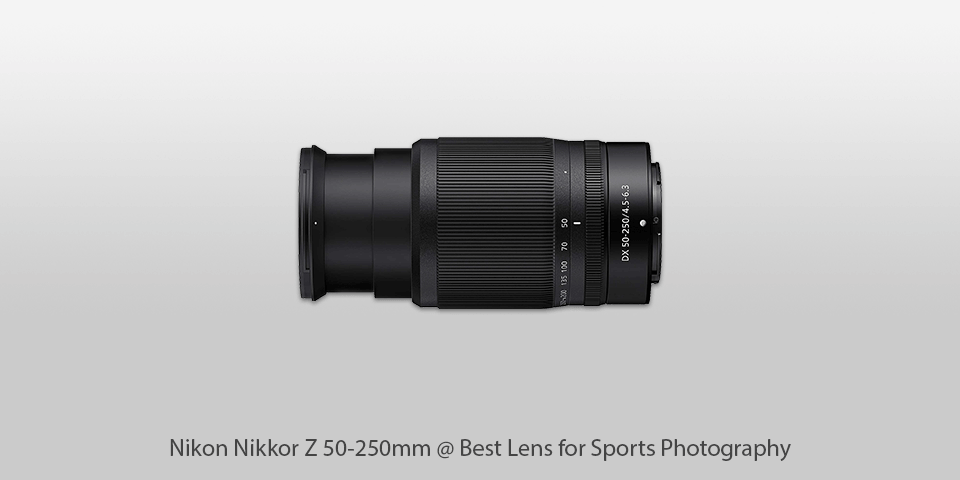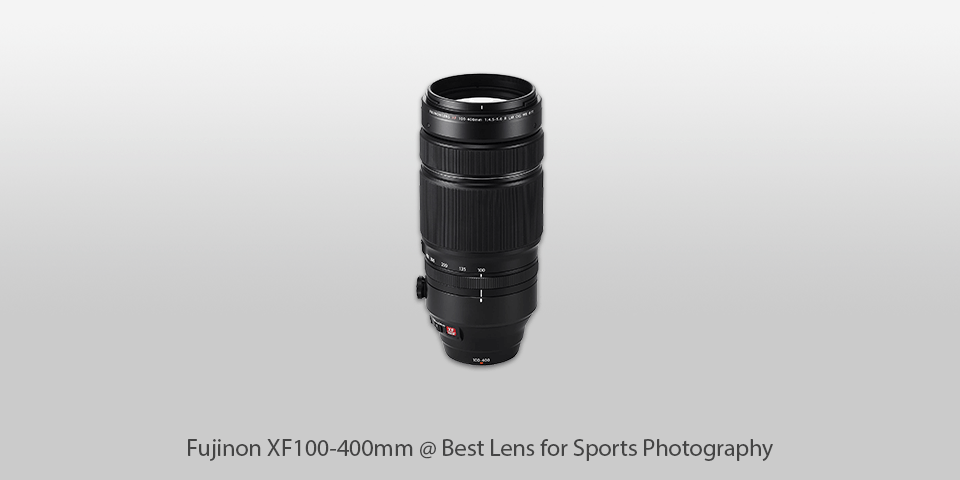Do you want to create stunning sports photos? In this article, you can find the best lens for sports photography in 2025 from Canon, Nikon and Sigma, which will help you capture the most important moments in sport that will make history.
I will tell you in detail about the best options for vernacular photography that will be suitable for photographers who take photos of professional and amateur sports events.
Regardless of what camera for sports you work with, you can find many good lenses that are perfect for sports photography. The options I have selected are great for this type of photography and will help you capture crunching tackles, one-handed catches and winning shots.

Mount: Canon EF | Diaphragm blades: 9 | Autofocus: Yes | Min focus distance: 1.20 m | Max magnification: 0.25x | Filter thread: 67 mm | Dimensions (WxL): 80x146 mm | Weight: 710g
⊕ Quick autofocus
⊕ Excellent image stabilization
⊕ Great build quality
⊖ Extra £75 for a hood
⊖ The lens isn’t weather-sealed
This is a new version of the original Canon EF 70-300mm f/4.5-5.6 IS lens, and it’s the best lens for sports photography. It’s suitable for both amateur and professional photographers who want to get a telephoto lens for various purposes, including sports and wildlife photography. This option is the first lens from Canon that comes with an electronic information display.
It looks like a small screen that shows important information, such as focal length, depth of field at different apertures, camera shake and focus distance. If you mount the lens on an APS-C camera, it will show the equivalent focal length, which will be very helpful to you.

Mount: APS-C | Diaphragm blades: 9 | Autofocus: Yes | Min focus distance: 450 m | Max magnification: 0.34x | Filter thread: 72 mm | Dimensions (WxL): 79 x 130.5 mm | Weight: 710g
⊕ Provides 22.2x zoom ratio
⊕ Great quality of the image
⊕ Image stabilization
⊕ Waterproof
⊖ No focus distance on the lens barrel
⊖ Noticeable distortion
The Tamron 18-400mm is a quite long sports camera lens, but it’s suitable for the APS-C SLR bodies, which it’s most likely to be used with. Its size is 4.9 x 3.1 inches (HD) at its shortest. When zoomed, it expands to 9 inches if you set it to the 400mm position. As for the performance and image quality, the Tamron is not worse than other superzoom lenses, such as the Sigma 18-300mm and Tamron 16-300mm, even though it has a very long maximum focal length. This lens will be ideal if you want the ultimate telephoto lens. However, the Tamron 16-300mm has a bit wider angle of view. It’s also smaller, weighs less and is more affordable.

Mount: Nikon F | Diaphragm blades: 9 | Autofocus: Yes | Min focus distance: 2.6 m | Max magnification: 0.2x | Filter thread: 105 mm | Dimensions (WxL): 121 x 290.2 mm | Weight: 2860 g
⊕ Super sharp
⊕ Little distortion
⊕ Great build quality
⊕ Weatherproof
⊖ Bulky
⊖ Quite a narrow aperture
The Sigma 150-600mm is a large and heavy lens for sports photography. Its size is 11.4 x 4.8 inches (HD) without the hood, and its weight is 6.3 pounds. The 105mm front element supports filters, but this lens doesn’t have a lens cap. Instead of it, there is a protective nylon cover. You need to put it on the front of the lens to protect the glass when the hood is inverted. When the hood is in its normal position, you won’t need a cap or cover as it perfectly protects the glass from damage. However, if you leave the lens uncovered, dust can easily get inside.

Mount: Nikon Z | Diaphragm blades: 7 | Autofocus: Yes | Min focus distance: 0.5 m | Max magnification: 0.23x | Filter thread: 62 mm | Dimensions (WxL): 74 x 110 mm | Weight: 400 g
⊕ Very lightweight
⊕ Compact when folded
⊕ Offers up to 5 stops of VR
⊖ Plastic build
⊖ Inconvenient control ring
⊖ The maximum aperture is slow
The Nikon Z DX 50-250mm f/4.5/6.3 VR is the best lens for sports photography that will be perfect for amateurs who want to start using mirrorless cameras or content creators who wish to replace their smartphones with something more interesting. The universal focal length range means that you can take pictures of anything, for instance, portraits, photos of sports events and wildlife, etc. This lens is made from plastic, but because of this, it’s so lightweight that you won’t even feel it on your camera.

Mount: Micro Four Thirds | Diaphragm blades: 7 | Autofocus: Yes | Min focus distance: 0.9 m | Max magnification: 0.18x | Filter thread: 58 mm | Dimensions (WxL): 69 x 116.5 mm | Weight: 423g
⊕ Small-sized
⊕ Lightweight
⊕ Quick focus
⊕ Inexpensive
⊖ Doesn’t have a lens hood
⊖ Image quality is poor at 300mm
The Olympus M.Zuiko Digital ED 75-300mm f/4.8-6.7 II is a universal and quite compact telephoto lens. It’s a 150-600mm equivalent lens for Micro Four Thirds mirrorless cameras. Due to the optical design, it uses three low-dispersion elements and three high refractive index elements, which control chromatic and spherical aberrations for better clarity and sharpness throughout the zoom range. Also, this lens uses a Movie & Stills Compatible AF system for a seamless, speedy and almost silent focusing, which allows capturing high-quality photos and videos.

Mount: APS-C Format | Diaphragm blades: 9 | Autofocus: Yes | Min focus distance: 1.75m | Max magnification: 0.19x | Filter thread: 77mm | Dimensions (WxL): 210.5mm x 94.8mm | Weight:1375g
⊕ Amazing optics
⊕ A long telephoto reach
⊕ Weatherproof
⊕ Compatible with teleconverter
⊖ Bigger than other mirrorless lenses
⊖ Expensive
The Fujinon XF100-400mm lens is a sports camera lens that is quite compact for its focal length range. It’s equivalent to 152-609mm if we are speaking about the 35mm image sensor format. This is a great range for the APS-C format. This option offers a robust telephoto zoom and the Fujifilm X-Pro2 body.

Mount: Canon EF | Diaphragm blades: 8 | Autofocus: Yes | Min focus distance: 1.20 m | Max magnification: 0.21x | Filter thread: 77 mm | Dimensions (WxL): 89x199 mm | Weight: 1440g
⊕ Amazing sharpness from edge to edge
⊕ Great build quality
⊕ Dust-proof, waterproof
⊕ Fluorine-coated lens
⊖ Some distortion
⊖ Poor vignette
The Canon EF 70-200mm f/2.8L IS III USM lens is not all that different from the earlier version, but it’s still the gold standard in its class. It has a large focus ring, which is ridged for a better grip. Both ends of the range have hard stops, which makes it easier to adjust focus at infinity. Polarizer users will like that the 77mm filter thread doesn’t rotate when they are focusing.
| Image | Name | Features | |
|---|---|---|---|
 |
Canon EF 70-300mm
Our Choice |
CHECK PRICE → | |
 |
Tamron 18-400mm F/3.5-6.3
Professional |
CHECK PRICE → | |
 |
Sigma 150-600mm 5-6.3
Budget |
CHECK PRICE → |

Wide-angle, telephoto, prime and zoom lenses are suitable for sports photography. Some professional photographers use medium focal length lenses too. The choice depends on your point of focus and what type of movement you want to shoot.
Since focus and motion are extremely important in sports photography, you have to get a lens that provides excellent precision. Determine your budget and create a list of the lenses that suit your needs. The price has to match the features of the lens. If you’re new to sports photography, then buying the most expensive lens won’t do you any good.
First, get a camera, then the lens. If you already have a camera, that’s great. If you don’t, then get a camera suitable for sports photography. Check its manual, and you will see a section dedicated to mounting a lens on it. Examine it and select a lens that is simple to mount, doesn’t fall off and is compatible with your camera. If you don’t follow these steps, you won’t achieve good results and will simply waste your time and effort.
Another essential thing you need to pay attention to when choosing a lens for sports photography is its image stabilization system. The image stabilization and shake reduction are indicated in the number of shutter speed stops. The higher the number is, the better the lens reduces shake. You need to have the image stabilization system for sports photography as sports players and objects usually move very fast. With image stabilization, you will be able to get sharp images of moving objects. Besides, thanks to a good image stabilization system, it’s possible to take photos at faster shutter speeds. The image stabilization possibilities of the Canon lenses are indicated by IS on its side. As for the Nikon lenses, there are letters VR that refer to it.

Choosing a photography lens is quite a difficult task, but I hope that this guide will help you do it. Use all the tips and tricks I’ve described, study all the pros and cons of the lenses, and you will definitely take your skills to a new level.
Experienced sports photographers use a shutter speed of around 1/1000 per second. In the daytime it’s easy but in the night you might need a faster F Stop than your lens can handle. To make a compromise, you can increase the ISO of your camera.
Aperture for sports pictures means the maximum aperture of your lens. F/4 and f/5.6 are standard telephoto lens maximum apertures, which will perfectly work for sports photos. If you need more depth of field, try using f/8 or f/11. Make sure to pay attention to your shutter speed.
Short telephotos and wide-angle lenses are great for taking close photos from far distances, but they can cause some problems. If you need a new lens for you camera for wildlife photography, plan to take candid portraits or anything that is far from you, the 70-200mm lens is a perfect option.
There are three main reasons for blur in sports pictures: the motion of the subject is too fast for the shutter speed you’ve set, the focus is off, or there is too much camera movement for the shutter speed you’ve selected.

 Rating
Rating